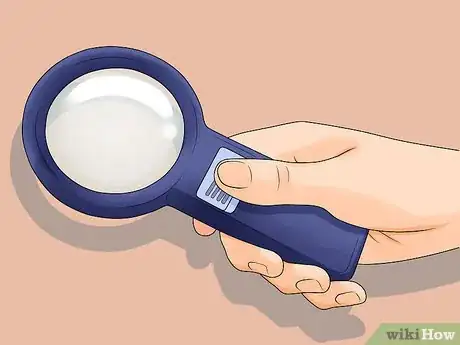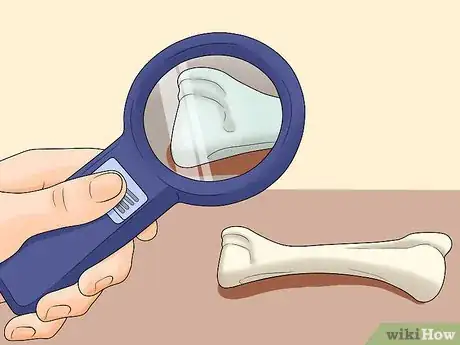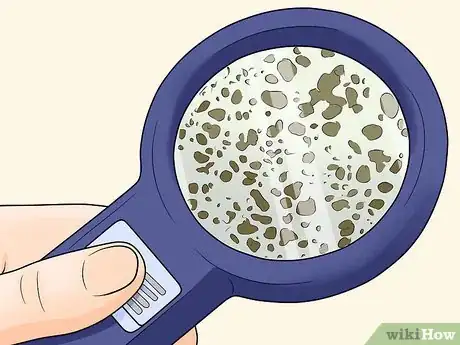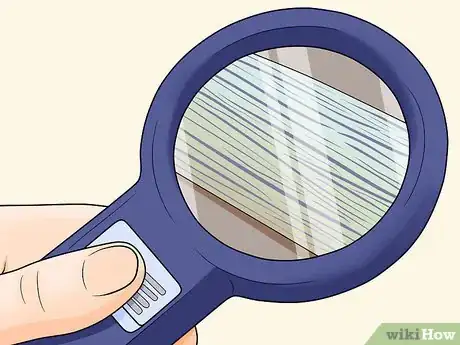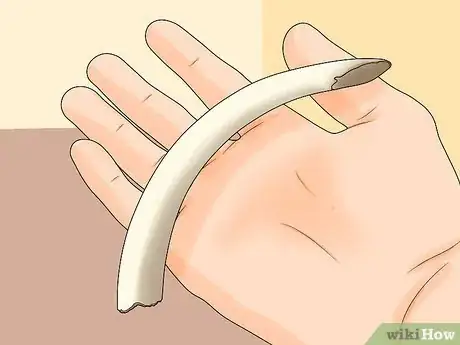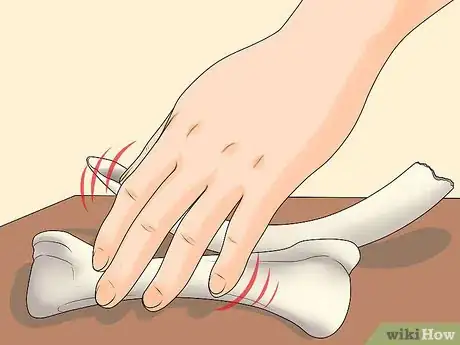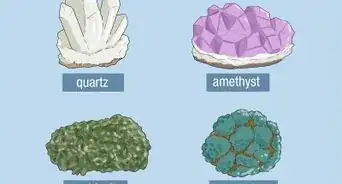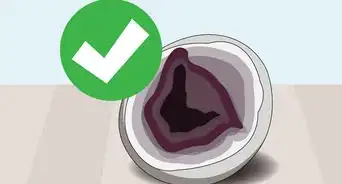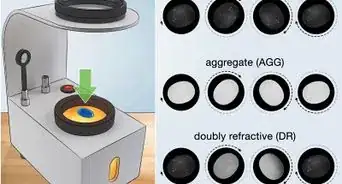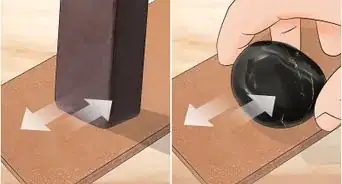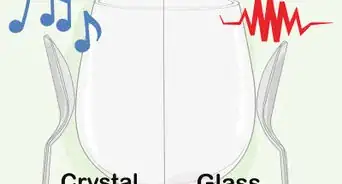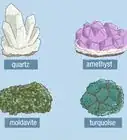This article was co-authored by Lois Wade, a trusted member of wikiHow's volunteer community. Lois Wade has 45 years of experience in crafts including sewing, crochet, needlepoint, cross-stitch, drawing, and paper crafts. She has been contributing to craft articles on wikiHow since 2007.
wikiHow marks an article as reader-approved once it receives enough positive feedback. This article received 19 testimonials and 89% of readers who voted found it helpful, earning it our reader-approved status.
This article has been viewed 785,012 times.
Learn more...
Ivory is made from the tusks and teeth of elephants, whales and several other animals. While bone and ivory can be similar in appearance, weight, and feel, ivory tends to be of higher value and more regulated than bone. Start by determining if the piece is bone or ivory rather than a synthetic or other replica material. After that, you can examine it under a magnifying lens to easily differentiate between these two materials.
Steps
Examining Under a Magnifying Lens
-
1Use an appropriate magnifying lens for your piece. Magnifying glasses come in a variety of sizes with a number of different special features. For most bone or ivory pieces, a standard strength, handheld magnifying glass works well, letting you see enough detail to distinguish between the two materials and control how close you are able to examine the piece. Handheld magnifying glasses can be purchased online or at some specialty and hobby retailers. You may also be able to find a handheld magnifying glass at some home décor shops.
- You can also use a microscope, but these tend to be more expensive than a magnifying glass, especially if your bone or ivory piece is large.
-
2Hold the magnifying glass over the piece. Hold the piece in your hand or place it on a flat surface. Hold your handheld magnifying glass over the piece, starting several inches away. Move the magnifying glass closer to the piece as needed until the details come into focus and you are able to see the intricate markings on the piece.[1]
- If you are using a microscope, set it up according to the instructions and focus the lens until the details on the piece become sharp and clear.
Advertisement -
3Look for pores to confirm the item is bone. Once the details on the piece become visible through your magnifying lens, examine closely to assess if the surface of the piece is covered with lines or pores. If the piece is porous, it is almost certainly bone.[2]
- Pores will look like very small dots or holes covering the surface of your piece.
-
4Examine for lines to determine that your piece is ivory. When you examine your piece under a magnifying glass, if you are looking at ivory, there will be lines on the surface.[3] The lines on genuine ivory can appear in a variety of ways, including straight, cross-hatched, or in a circular motion.
Checking for Authenticity
-
1Hold the piece in your hand to assess the weight. Ivory and some types of bone are heavy and dense in weight, comparable to a similarly sized billiard ball. If the piece feels lightweight, you can eliminate the possibility that it's ivory, though it could be bone.[4]
- Bone and ivory can weigh the same. If a piece feels solid and heavy, that doesn't necessarily mean it's ivory. This does, however, serve as an indicator that it might be one of the two.
- If you're unsure whether the item feels appropriately solid, use a scale to weigh it. While the weight of different types of ivory can vary, popular types of ivory, such as tusks, generally weigh about 1.4 pounds (0.64 kg) per 1 inch (2.5 cm) in length.[5]
-
2Examine the piece under a black light. Find and purchase a black lightbulb (also referred to as an ultraviolet light) or a black light flashlight. If using a lightbulb, screw the bulb into a lamp, preferably in a room with little natural light. Turn on the black light lamp or black light flashlight. Turn out any other lights, making the room as dark as possible. With only the black light on, examine the piece to assess what color it illuminates. Genuine ivory and bone both appear bright white under a black light, whereas synthetic materials tend to absorb more light and appear dull.[6]
- While it is rare, there are some replica or synthetic materials that might also appear white under a black light, so you will need to perform multiple tests to be sure that your piece is authentic bone or ivory.
-
3Feel the surface for smoothness and hardness. Run your finger over the piece to assess how smooth the surface is, and how durable it feels. Ivory, along with many types of bone, are very smooth to the touch, and feel substantial, hard, and durable. If the surface is rough or feels soft or flimsy, it is very unlikely that your piece is genuine ivory or bone.
- Although some types of bone can feel as smooth as ivory, most do not. Bone is porous and therefore, tends to feel slightly rougher than ivory. If your piece feels buttery smooth to the touch, this may be an indication that the item is ivory, but you will still need to do additional testing to confirm.[7]
- While bone can be as durable as ivory, this is not always the case. You may be able to easily break a small bone, for example, but it is unlikely that you would be able to break a small piece of ivory.
- When examining your piece for hardness, use extra care, as synthetic and bone pieces may be easily damaged.
-
4Look for natural yellowing due to age. Unlike synthetic materials (which are often made to hold their color), both ivory and bone naturally change color as they age. While both ivory and bone can age with a yellowish tint, bone may also turn a slight brown, red, white, or green.[8] If your piece has an aged yellow tint, this may indicate that it is ivory or bone.
- Some faux ivory or bone pieces are manufactured with a yellowish tint in order to appear authentic. As a result, additional testing is necessary to confirm that your piece is either bone or ivory, as well as to determine which of these two materials it is.
Community Q&A
-
QuestionI have a small elephant I believe to be ivory. It has weight, correct color, buttery smooth surface, and passed the "hot pin" test. The piece was my mother's and I believe it's quite old. Is it legal to sell this and if so, how do I establish its value?
 Community AnswerIf your piece was acquired before the 1972 ban on elephant ivory, it is legal to sell it. It also might be an antique, which makes it even more valuable. I recommend you take it to an antique dealer who has experience with ivory. That's the best of the lower priced ways to find out. To see what carved mammoth ivory is selling for these days, check out Trader Jack's website. He's a carved mammoth ivory seller based in Washington state and very trustworthy.
Community AnswerIf your piece was acquired before the 1972 ban on elephant ivory, it is legal to sell it. It also might be an antique, which makes it even more valuable. I recommend you take it to an antique dealer who has experience with ivory. That's the best of the lower priced ways to find out. To see what carved mammoth ivory is selling for these days, check out Trader Jack's website. He's a carved mammoth ivory seller based in Washington state and very trustworthy. -
QuestionHow can I tell if something is ivory?
 Community AnswerThis article gives many tips on identifying ivory. This includes things like noticing its weight, patina, texture as well as other tests to determine if it is ivory or not. The best thing to do would be to read the entire article.
Community AnswerThis article gives many tips on identifying ivory. This includes things like noticing its weight, patina, texture as well as other tests to determine if it is ivory or not. The best thing to do would be to read the entire article. -
QuestionWon't the hot needle test cause items made from nitrocellulose to explode or combust?
 Community AnswerNo, nitrocellulose is the name of a large group of chemical substances that are highly flammable and explosive, but I really don't think they would make any houseware out of such a type of nitrocellulose. However , if you do the needle test, don't insist too much, or some items could start burning.
Community AnswerNo, nitrocellulose is the name of a large group of chemical substances that are highly flammable and explosive, but I really don't think they would make any houseware out of such a type of nitrocellulose. However , if you do the needle test, don't insist too much, or some items could start burning.
Warnings
- While some resources may suggest using the hot pin test to distinguish between bone and ivory, this test can char and damage or ruin your piece and is not recommended by experts.[9]⧼thumbs_response⧽
- If your piece is ivory, it is a good idea to confirm the legality of the item and learn what you are legally allowed to do with that particular type of ivory. African elephant ivory is particularly highly regulated, for example, and is only legal for sale if you can prove that your ivory was lawfully imported prior to January 18, 1990.⧼thumbs_response⧽
References
- ↑ https://www.realorrepro.com/article/Ivory-genuine-fake--confusing
- ↑ http://www.differencebetween.net/object/difference-between-ivory-and-bone/
- ↑ http://www.differencebetween.net/object/difference-between-ivory-and-bone/
- ↑ https://www.ebay.com/gds/how-to-tell-if-ivory-is-genuine-or-not-includes-pics/10000000010311348/g.html
- ↑ https://www.britannica.com/topic/ivory
- ↑ https://www.realorrepro.com/article/Ivory-genuine-fake--confusing
- ↑ http://www.differencebetween.net/object/difference-between-ivory-and-bone/
- ↑ https://bonesdontlie.wordpress.com/2011/10/06/colored-bones-varied-meanings/
- ↑ https://www.realorrepro.com/article/Ivory-genuine-fake--confusing
About This Article
To tell if something is ivory or bone, you'll need a handheld magnifying glass so you can examine the object closely. Place the object on a flat surface, and hold the magnifying glass a few inches away. You may need to move it closer or further away until it focuses. Once it's focused, carefully examine the surface of the object to see if it's covered with either pores or lines. If it's covered with pores, or small holes, it's most likely made of bone. Alternatively, if it's covered in straight, cross-hatched, or swirled lines, it's most likely ivory. To learn how to tell is bone or ivory is real or fake, keep reading!
